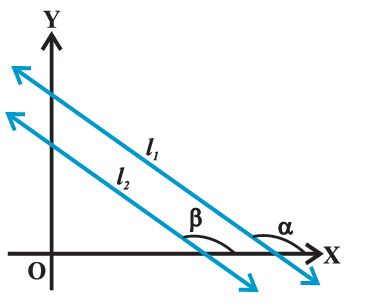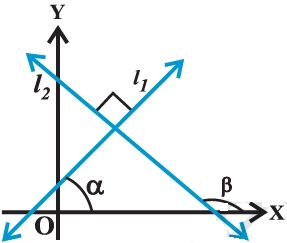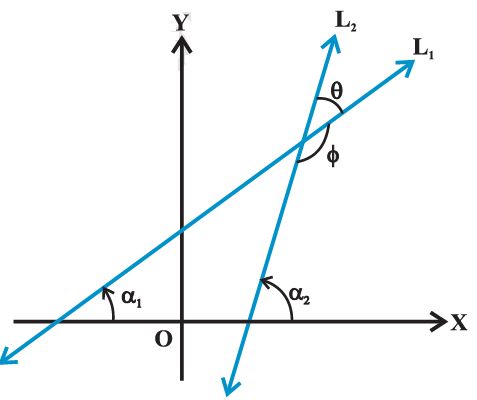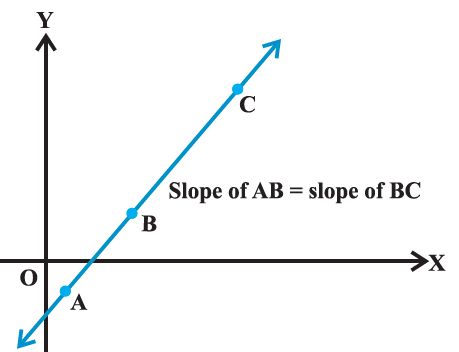- Books Name
- AMARENDRA PATTANAYAK Mathmatics Book
- Publication
- KRISHNA PUBLICATIONS
- Course
- CBSE Class 11
- Subject
- Mathmatics
Conditions for parallelism and perpendicularity of lines and Collinearity of three points:

In a coordinate plane, suppose that non-vertical lines l1 and l2 have slopes m1
and m2, respectively. Let their inclinations be a and b, respectively.
If the line l1 is parallel to l2 (Fig 10.4), then their
inclinations are equal, i.e.,a = b, and hence, tan a = tan b
Therefore m1 = m2, i.e., their slopes are equal.
Conversely, if the slope of two lines l1 and l2 is same,
i.e., m1 = m2.
Then tan a = tan b.
By the property of tangent function (between 0° and 180°), a = b.
Therefore, the lines are parallel.
Hence, two non vertical lines l1 and l2 are parallel if and only if their slopes are equal.
If the lines l1 and l2 are perpendicular , then b = a + 90°.
Therefore, tan b = tan (a + 90°)
= – cot a = -1/ tan a
i.e., m1= -1/m2 or m1 m2 = -1

Conversely, if m1 m2 = – 1, i.e., tan a tan b = – 1.
Then tan a = – cot b = tan (b + 90°) or tan (b – 90°)
Therefore, a and b differ by 90°.
Thus, lines l1 and l2 are perpendicular to each other.
Hence, two non-vertical lines are perpendicular to each other if and only if their slopes are negative reciprocals of each other,
Example: Line through the points (–2, 6) and (4, 8) is perpendicular to the line
through the points (8, 12) and (x, 24). Find the value of x.
Solution: Slope of the line through the points (– 2, 6) and (4, 8) is
m = (8 – 6) /(4 – (-2)) = 2 / 6 = 1/ 3
Slope of the line through the points (8, 12) and (x, 24) is
m = (24 – 12) /(x – 8) = 12 / (x-8)
Since two lines are perpendicular,
m1 m2 = –1, which gives
- [12 / (x-8)] . [1 / 3] = - 1
- 4 / ( x – 8 ) = - 1
- x – 8 = - 4
- x = 4
Angle between two lines
Let L1 and L2 be two non-vertical lines with slopes m1 and m2, respectively. If a1 and a2 are the inclinations of lines L1 and L2, respectively. Then m1= tan a1 and m2=tana2
Let q and f be the adjacent angles between the lines L1 and L2 . Then q = α2 - a1 and a1, a2 ¹ 90o

Therefore tan q = tan (a2 – a1) =[ tana2 – tana1] / [1+ tana2 –tana1] = [m2-m1] / [1+ m1m2]
(as 1 + m1m2 ¹ 0)
and f = 180° – q so that
tan f = tan (180° – q ) = – tan q = - [m2-m1] / [1+ m1m2] (as 1 + m1m2 ¹ 0)
Now, there arise two cases:

which means that q will be obtuse and f will be acute.
Thus, the acute angle (say q) between lines L1 and L2 with slopes m1 and m2,
respectively, is given by

![]() ……………………(1)
……………………(1)
The obtuse angle (say f) can be found by using f =1800 – q.
Example: If P (-2, 1), Q (2, 3) and R (-2, -4) are three points, find the angle between the straight lines PQ and QR.
The slope of PQ is given by
m = ( y2 – y1 ) / (x2 – x1)
m =( 3 – 1 ) / (2 – (-2 ))
m= 2/4
Therefore, m1=1/2
The slope of QR is given by
m= (−4−3) / (−2−2)
m= 7/4
Therefore, m2 = 7/4
Substituting the values of m2 and m1 in the formula for the angle between two lines when we know the slopes of two sides, we have,
tan θ=± (m2 – m1 ) / (1+m1m2)
tan θ=± ((7/4) – (1/2) ) / (1+ (1/2)(7/4))
tan θ=± (2/3)
Therefore, θ = tan -1 (⅔)
Co linearity of three points
We know that slopes of two parallel lines are equal. If two lines having the same slope pass through a common point, then two lines will coincide. Hence, if A, B and C are three points in the XY-plane, then they will lie on a line, i.e., three points are collinear if and only if
slope of AB = slope of BC.

Example: Three points P (h, k), Q (x1, y1) and R (x2, y2) lie on a line. Show that
(h – x1) (y2 – y1) = (k – y1) (x2 – x1).
Solution : Since points P, Q and R are collinear, we have
Slope of PQ = Slope of QR,


or (h – x1) (y2 – y1) = (k – y1) (x2 – x1).

 KRISHNA PUBLICATIONS
KRISHNA PUBLICATIONS
